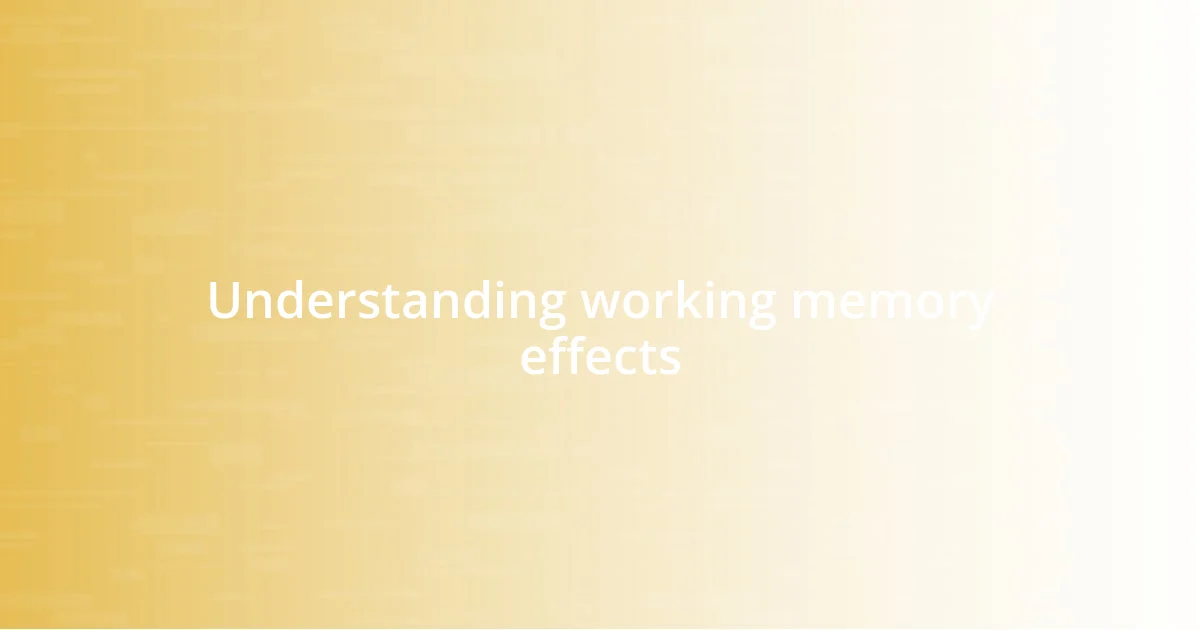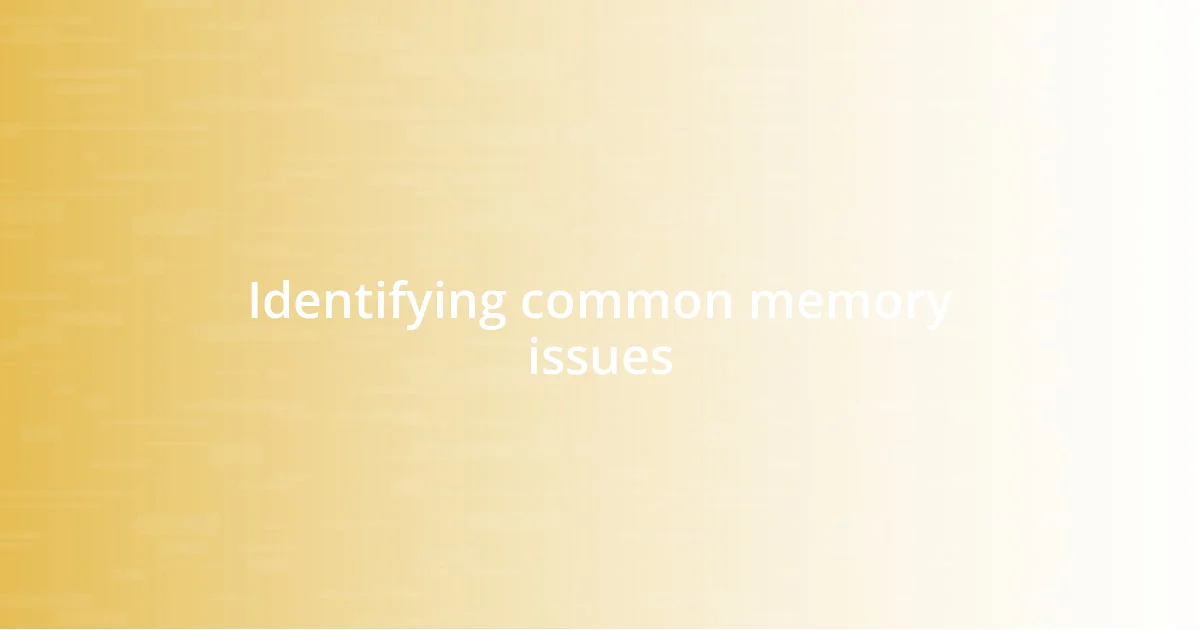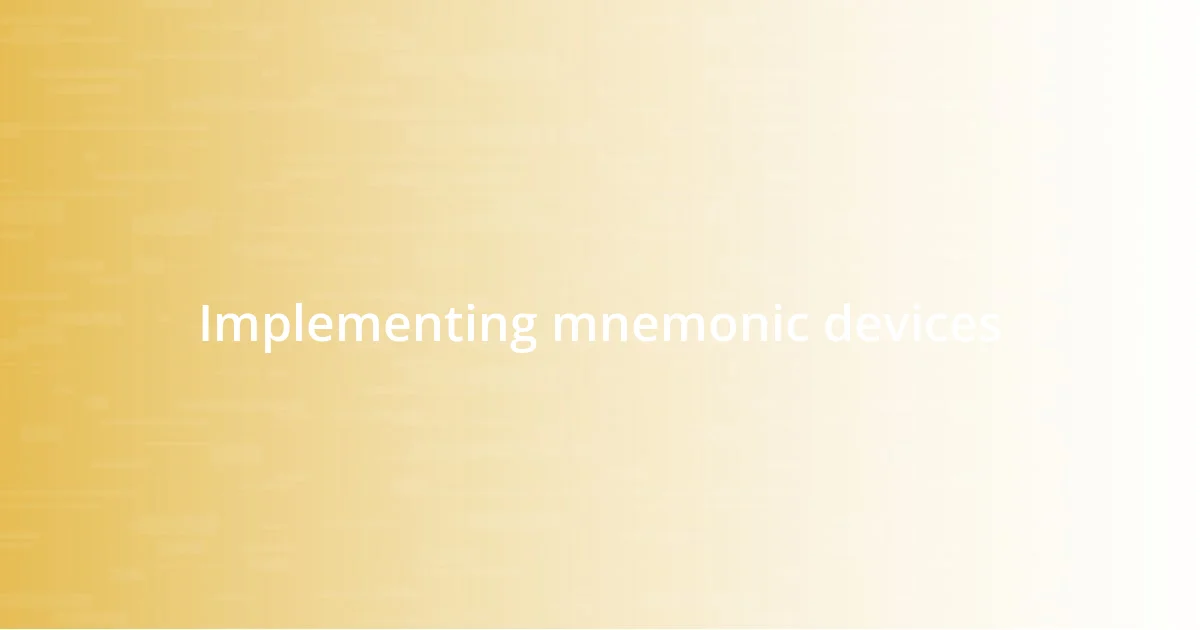Key takeaways:
- Understanding working memory is crucial for improving information retention, as cognitive overload can hinder our ability to recall important details.
- Employing mnemonic devices, mindfulness techniques, and engaging in physical exercises can significantly enhance working memory through creative strategies and mental clarity.
- Tracking progress and making adjustments based on individual performance leads to better memory outcomes and insights into effective learning habits.

Understanding working memory effects
Understanding working memory is essential because it impacts how we process information daily. Have you ever found yourself trying to remember a phone number only to lose track as soon as you get distracted? That’s the struggle of working memory—it’s our mind’s temporary storage system, and when it’s overloaded, we can easily forget or mix up important details.
I recall a time during college when juggling multiple assignments became overwhelming. I noticed that my ability to remember crucial points from lectures diminished as stress crept in. This firsthand experience truly highlighted how the effects of working memory can ripple into every aspect of learning and productivity.
When we understand the nuances of working memory, it’s easier to implement strategies to improve it. For instance, I began using mnemonic devices—simple memory tricks that transformed my studying experience. Have you tried finding ways to make information stick? Exploring those techniques can make a significant difference and help energize our cognitive capacities.

Identifying common memory issues
Identifying common memory issues is essential to understanding where we might need improvement. One prevalent problem I’ve noticed is the inability to recall names or faces shortly after meeting someone. This can be particularly frustrating, especially during networking events. I remember attending a conference where I met dozens of people, and by the end of the day, I could hardly remember their names. It’s a classic case of cognitive overload.
Another common memory issue arises from multitasking. I’ve often caught myself trying to juggle several tabs on my computer while talking on the phone. The result? I end up forgetting important details from both tasks. This experience taught me that splitting my attention only dilutes my memory capacity, making it harder to retain information. It’s a real struggle that many people face in today’s fast-paced world.
Lastly, age-related memory decline is something we all might encounter as we grow older. I’ve noticed that my parents sometimes misplace common items or frequently ask the same question. It’s not just about aging; it’s also about how we adapt to those changes. Recognizing these common memory issues can pave the way for strategies to enhance our working memory.
| Memory Issue | Description |
|---|---|
| Forgetting Names | Difficulty recalling names shortly after meeting someone. |
| Multitasking | Struggling to remember information when splitting attention. |
| Age-Related Decline | Challenges in memory as we grow older. |

Implementing mnemonic devices
Implementing mnemonic devices can be a game changer for enhancing working memory. I remember when I started utilizing acronyms in my studies, specifically for subjects like biology. Instead of struggling to remember the order of the planets, turning “My Very Educated Mother Just Served Us Noodles” into an acronym transformed a cumbersome task into something far more manageable and, dare I say, enjoyable! Mnemonics not only made the information stick, but they also injected a bit of creativity into my learning process.
Here are some popular mnemonic devices I’ve found particularly useful over the years:
- Acronyms: Create a word from the initial letters of the items you’re trying to remember.
- Rhymes: Use catchy phrases or songs to enhance memorization. For example, “30 days hath September…”
- Visual Imagery: Link concepts with vivid mental images. Imagine a giant dog to remember “dog” instead of just a written note.
- Chunking: Break down information into smaller, digestible parts, like memorizing a long number as smaller groups (e.g., 123-456-789).
- Method of Loci: Visualize a familiar place and associate items you want to remember with specific locations within that space.
Using these techniques can turn the daunting task of memorization into a fun challenge. I’ve often found myself laughing while imagining bizarre scenarios to remember lists—it’s surprisingly effective! Embracing mnemonic devices allows us to tap into our creativity, giving our brains a unique way to retain information in this fast-paced world.

Practicing mindfulness techniques
Practicing mindfulness techniques has been a transformative experience for me, especially regarding working memory. I recall vividly sitting in a crowded café, attempting to juggle my thoughts and external distractions. It was in that moment of chaos that I discovered the power of focused breathing. As I inhaled deeply and exhaled slowly, I noticed how my racing thoughts began to quiet. This simple act of mindfulness helped me to ground myself and improve my ability to retain information, even in a bustling environment.
Engaging in mindfulness exercises, such as meditation, has also become essential in my daily routine. I’ve found that dedicating just ten minutes a day to sit quietly and observe my breath allows me to clear mental clutter. During these sessions, I often ponder: “What’s more important than being present?” This reflection reminds me that staying mindful not only enhances my memory but also enriches my overall well-being. I’ve noticed that I’m much sharper and more attentive post-meditation, enabling me to remember key details from conversations or tasks.
I’ve even started incorporating mindfulness into mundane activities, like washing dishes. Instead of letting my mind wander, I focus on the sensations—the warmth of the water, the sound of the plates clinking. This practice has surprisingly improved my working memory by teaching me to anchor my thoughts. Have you ever considered how being fully present can change how you process and remember information? I can assure you that integrating mindfulness into everyday life leads to a significant improvement in cognitive functions, including memory retention.

Engaging in physical exercises
Engaging in physical exercises is one of the most effective strategies I’ve discovered for enhancing working memory. I remember participating in a local charity run not too long ago. It was challenging, not just physically but mentally too, as I had to keep track of my pace, breathing, and the overall route. Surprisingly, the combination of movement and concentration sharpened my focus, and I ended up recalling details from my studies with much more clarity afterwards. Isn’t it fascinating how our bodies and minds work symbiotically?
I’ve also explored activities like yoga and dancing, which blend physical movement with mental engagement. When I’m on the mat, the intricate poses require me to concentrate, reminding me to stay present and attentive. I often think about the unique way these exercises connect my mind and body, a dual workout that reinforces my ability to grasp and retain information. Can you believe that something as simple as flowing through a sequence of movements can stimulate brain function? It’s an exhilarating feeling to experience physical strength reinforcing my cognitive skills.
Moreover, I’ve found that even a brisk walk outside can improve my mood and sharpen my memory. On days when I felt mentally drained, stepping into nature revitalized me. The fresh air and rhythmic movement freed my mind from distractions, enabling me to process and remember information more effectively. Have you ever noticed how a change in scenery can impact your thinking? For me, this simple act of physical exercise became a refreshing reset for my working memory, proving that sometimes, all we need is to move to boost our brainpower.

Utilizing memory enhancement games

Utilizing memory enhancement games
I’ve discovered that memory enhancement games can be both entertaining and beneficial for improving working memory. Recently, while trying out a popular app focused on memory exercises, I found myself completely immersed. I was so engaged that I lost track of time, yet I noticed my ability to recall details from my day-to-day life was noticeably sharper afterwards. Isn’t it amazing how something that feels like pure fun can double as a powerful brain workout?
One game that stood out for me involved remembering sequences of colors and numbers. I still vividly remember the sense of accomplishment I felt as I progressed to higher levels. With each challenge, my concentration improved, and I became more adept at juggling multiple pieces of information. Have you ever felt that thrill when you realize you’ve not only learned something new but have also pushed your boundaries? Such moments are invigorating and create a strong desire to keep learning and sharpening my memory.
Furthermore, I appreciate how these games often come with a social aspect, allowing me to compete with friends or family. I fondly recall a weekend gathering where we challenged each other with memory games. The laughter, combined with friendly competition, made the experience incredibly enjoyable. It’s fascinating how sharing a memory challenge can strengthen connections while enhancing cognitive skills at the same time. Do you have any favorite activities that combine fun and mental stimulation? For me, memory games have become a delightful habit that nourishes my mind while keeping everyday interactions vibrant.

Tracking progress and adjustments
Tracking progress in improving working memory is essential for understanding what works and what needs adjustment. I often keep a journal of my memory exercises and games, noting my performance and feelings after each session. This simple habit has not only allowed me to recognize my strengths and weaknesses but also helped me identify patterns in my progress—like the times I perform best after a good night’s sleep. Have you ever taken the time to reflect on how your mental clarity fluctuates with your daily routines?
Making adjustments based on my progress has led to significant breakthroughs as well. For example, I realized that certain memory games were more effective when I played them at specific times of the day. When I switched my gaming sessions to the mornings, my focus was sharper, and I retained the information much better. How incredible it is to discover that simply changing my environment could lead to improved results!
Each time I adjust my strategies based on the insights I gather, I feel a renewed sense of motivation. There’s something incredibly rewarding about tracking these small victories, like noticing how I can recall a complex series of numbers with ease after consistent practice. It’s a bit like watching a garden bloom; an ongoing commitment yields growth. Do you keep track of your progress? I truly believe that this reflective practice can turn little victories into major improvements in our cognitive capabilities.















